Culturally Sensitive Photography
Like Travel Itself, Photography
Builds Bridges
Article and photos by Jim
Kane
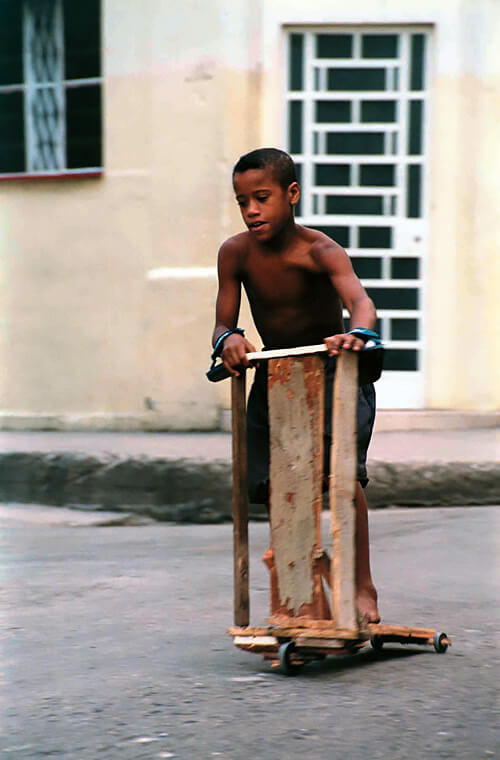
|
|
A Cuban boy rides
his home-made scooter in the streets of Havana.
|
When I think of travel
and photography it’s difficult to separate the two.
For me photography helps to capture and transmit the sense
of place that makes the destination special. Through the
personalities of its people, a country comes alive, both
in person and through photography.
Inevitably, the question
arises “How do you know when it’s alright to
take photos of people in other countries?” After all,
there are major cultural differences in how being photographed
is perceived and often an economic disparity between photographer
and potential subject.
The answer is that responsible
photography is very much like responsible travel. With a
thorough knowledge of the place you’re visiting, a
genuine interest in sharing and not just taking, an alert
intuition, an open mind, enough time, and a little luck,
photography abroad — just like travel itself — can
be a vehicle to build bridges. Ultimately, photography is
ideally a form of exchange.
By following these eight
guidelines while abroad your photographic efforts will become
more rewarding for photographer and subject alike:
1) Be an informed
photographer
Invest
time before traveling to research the customs and photography
mores of the place you will visit. Customs vary not only
by country but by region and religion as well.
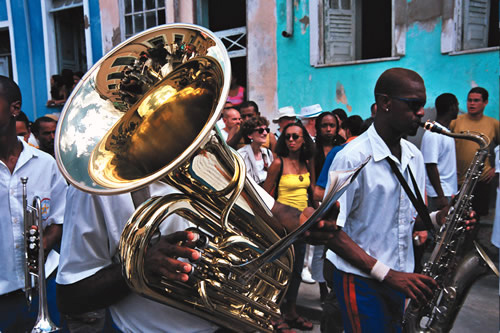
|
|
Music is part of the living
fabric of Brazil, no more so than on festival days.
|
2) Get comfortable with yourself
Self
confidence, an open attitude, and a genuine smile are important
wherever you travel. People will generally respond to you
with the same attitude that you exude. Conversely, if you
are nervous and “sneak around” with your camera
because of shyness or insecurity, they will feel this and,
worse, feel they are being used.
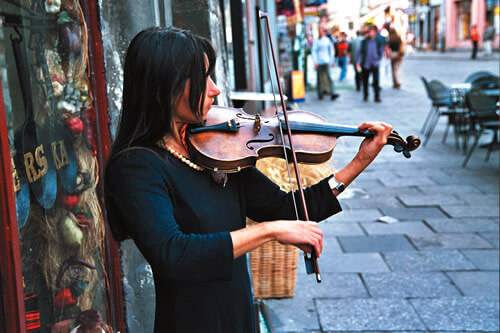
|
|
A violinist makes wonderful
music in the streets of Krakow, Poland.
|
3) Communicate
with subjects about photographs
It
only takes a simple gesture and a smile for a subject in
a foreign land to understand your interest in taking a photograph.
You’ll immediately get a clear indication of whether
they are a consenting subject. Not understanding the language
should never be an excuse to photograph an unwilling person.
Learning some simple phrases related
to photography in the language of the country in which you
are traveling not only allows you to communicate more directly
with your subject, explaining why you want to take a photograph,
it shows your interest in learning at least some of the
local language.
4) Take the at home test
You
should treat people abroad with the same respect and courtesy
as you would at home. If you find yourself questioning the
appropriateness of a certain shot, ask yourself if you’d
take the same picture in your home country without feeling
awkward.
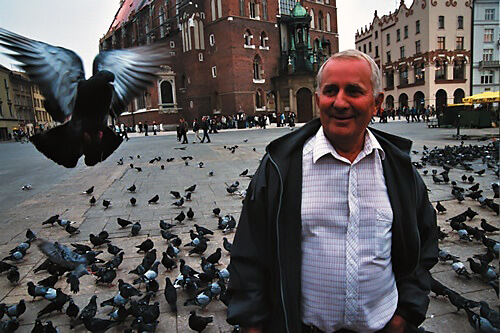
|
|
Pigeons in Krakow's main plaza
delight locals and visitors alike.
|
5) Spend time without shooting
photographs
Once
while riding through rural Thailand on a moped, I stumbled
across some kids playing ping-pong behind a temple. Wanting
to capture this wonderful scene, I just stood there and
watched the kids at play without touching the camera. After
a few minutes I asked (through gestures) if I could play.
This was met with smiles and a paddle was immediately thrust
at me. Five minutes later I returned the paddle, smiled,
and thanked them. Only then did the camera come out. Not
only did I feel at ease taking the pictures, the kids were
also much more relaxed with my presence.
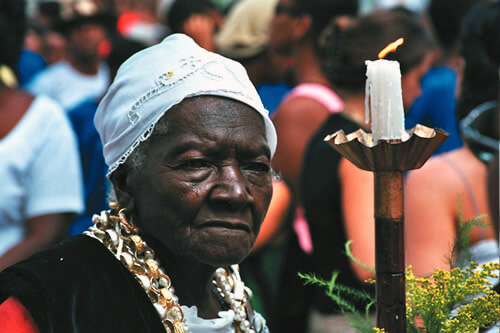
|
|
A dignified member of the Good
Death Sisterhood marches during the organization's
annual celebration in Cachoeira, Brazil.
|
6) Use an ice-breaker
before photos
Instantly
showing people the photos you’ve taken of them can
be a wonderful ice-breaker. The photography becomes less
intimidating and more fun for kids and adults alike. They
may even want to turn the tables and photograph you!
7) Give and take as a photographer?
One
of the most controversial situations while abroad is the
question of giving money to people you photograph. We’ve
all been in situations where a once un-touched indigenous
community becomes popular with camera-toting tourists. Soon,
there is a bustling business in “authentic” photos
for a dollar each and mobs of children running up to visitors
shouting, “photo, Mister?” On the other hand,
isn’t a person you’ve photographed entitled
to some form of compensation? After all, you’re benefiting
from their presence, personality, customs, clothing, etc.
Engaging people openly and sharing
time, a story, or a drink together is often the greatest
gift for both sides. However, if it is made clear that someone
expects money for a photograph, the decision becomes not
whether to pay, but whether to take the photo. That must
remain a judgment call that each of us needs to make on
a case-by-case basis.
8) No means no
when taking a photograph
When
someone objects to your taking a photograph you must respect
them, even if you don’t agree with or understand their
reasons. You are a guest and you must respect their decision.
One recent experience comes to mind.
There’s a church in San Juan Chamula in Chiapas, the
interior of which is nearly indescribable, because of the
blend of customs the people have adopted. There are no pews,
only two long rows of saints bordering a wide, straw-covered
floor where scores of people sit in individual prayer areas
and surround themselves with incense and colored candles.
As a passionate photographer, it killed
me not to be able to capture and transmit this unique display
of spirituality. However, there was no misunderstanding
the stern and repeated prohibition of photography inside
the church. For the people of San Juan Chamula photographing
this scene and the people inside would have shown a terrible
lack of respect.
So the interior remains unphotographed.
And perhaps that’s not so bad. Now, in order to understand
this wonderful and mysterious place, one must travel there,
step inside, live and breathe it. Sometimes there’s
just no replacing the real experience.
JIM KANE has written
frequently for Transitions Abroad on travel with a community-based
emphasis. He is the founder and
CEO of award-winning Culture
Xplorers, a recognized leader in sustainable travel.
|
